Search the website:
-
BUY THE BOOK

AVAILABLE VIA
-
Recently
- 2/21/23 at the Natural History Museum of Utah: “Chasing Shiva: The Hunt for Looted South and Southeast Asia Antiquities” September 2, 2023
- UPDATED > USA vs One Ancient Mosaic: A Looted Syrian Masterpiece in Los Angeles May 26, 2018
- The Sidon Bull’s Head: Court Record Documents a Journey Through the Illicit Antiquities Trade September 24, 2017
- Hobby Lobby’s Legal Expert Speaks: “I can’t rule out…they used my advice to evade the law.” July 10, 2017
- UPDATED > Help Wanted: We’re Tracking Down Objects Sold By Nancy and Doris Wiener January 5, 2017
- UPDATED > Manhattan Dealer Nancy Wiener Arrested: Criminal Complaint Alleges Sweeping Conspiracy to Sell Stolen Asian Art Through Major Auction Houses December 21, 2016
- UPDATED > Inside the ISIS Looting Operation: U.S. Lawsuit Reveals Terror Group’s Brutal Bureaucracy of Plunder December 15, 2016
- The End of the Beginning: NGA Returns Kushan Buddha and Two Kapoor Objects September 18, 2016
- The Missing Link: Subhash Kapoor’s Suppliers in India Are (Finally) Getting Rolled Up July 3, 2016
- The Lessons of Palmyra: Iconoclasm in the era of Clickbait April 7, 2016
- UPDATED > Asia Week Arrest: Japanese Dealer Convicted Of Selling Stolen Art March 19, 2016
- Asia Week Raids: New Details on the Christie’s Seizures March 18, 2016
- Busted: Asia Week Raids Reveal Scope of Illicit Trade in Asian Art March 17, 2016
- The Crennan Report: The NGA’s Ex Post Facto Due Diligence Finds 22 “Questionable” Asian Antiquities February 17, 2016
- Operation Antiquity: Prison for Antiquities Dealer Behind Looting and Tax Fraud Scheme December 15, 2015
- Ball State’s Kapoor Return Reveals New False Provenance November 17, 2015
- The Seated Buddha Goes Home: Nancy Wiener and National Gallery of Australia Will Return Sculpture to India March 5, 2015
- The Kushan Buddhas: Nancy Wiener, Douglas Latchford and New Questions about Ancient Buddhas February 1, 2015
- Danti’s Inference: The Known Unknowns Of ISIS and Antiquities Looting November 18, 2014
- Hecht’s Footprints: Haverford College Opens Up About Source of Their Greek Vases November 4, 2014
-
Join 1,764 other subscribers
What we’re talking about
AAMD American Numismatic Society antiquities Aphrodite archaeology Arnold-Peter Weiss art crime Arthur Houghton Art of the Past Asian Civilizations Museum book review Cambodia Chasing Aphrodite Christies Cleveland Museum Dallas Museum of Art David Gill Dietrich von Bothmer Douglas Latchford Edoardo Almagià Elie Borowski Events FBI Gary Vikan Getty Museum Getty Villa Giacomo Medici Gianfranco Becchina Hugh Eakin illicit antiquities Immigration and Customs Enforcement India Italy J. Paul Getty Museum J. Paul Getty Trust James Cuno james grimaldi Jane Levine Jim Cuno Jiri Frel Khmer Kimbell Art Museum Koh Ker Loot looted antiquities looting Marion True Metropolitan Museum of Art Michaela Boland Michael Padgett museums Nancy Wiener National Gallery of Australia New York Review of Books Nomos AG Norton Simon Museum numismatics Princeton University repatriation Robert Hecht Robin Symes Ron Radford SAFE scandal Selina Mohamed Sicily Sotheby's Subhash Kapoor Tamil Nadu The Art Newspaper Timothy Potts Turkey Vijay Kumar Walters Museum of Art WikiLoot David Gill’s Looting Matters
David Gill’s Looting Matters- Another Bubon bronze head likely to be repatriated
- The Stern Collection in New York: Cycladic or Cycladicising?
- The Carlos Museum: Time to Reflect?
- Returns to Greece from Michael C. Carlos Museum
- Silver Pyxis Lid Returned from VMFA
- Gnathian Askos Returned from Virginia MFA
- Virginia MFA Returns Antiquities
- Bubon Bronzes Returning to Türkiye
- The Parthenon Sculptures and the political arena
- The Wild Goat Plate Fragment and Francavilla Marittima
 Paul Barford’s Portable Antiquities and Heritage Issues
Paul Barford’s Portable Antiquities and Heritage Issues- Edutainer thinks it's time for What he calls "Toxic Archaeology" to End [UPDATED]
- Discussing Artefact Provenance
- Milo Rossi: You Tube Pseudoscience Commentator "Miniminuteman" [UPDATED]
- Graham and Holly Take on Archaeology
- Heritage in Danger: Hammer-Wielding Fanatics in Museum Gallery
- More on those Hyper-Precise "Ancient Lathe-Turned Vessels" from the Antiquities Market
- UK Museum Theft
- British Archaeology and Duodecahedral Mystery Fever (I): The PAS Boost Their Recording Statistics
- British Archaeology and Duodecahedral Mystery Fever (II): The Archaeology Group Struts its Stuff
- British Archaeology and Duodecahedral Mystery Fever (III): This is Mine!
 Derek Fincham’s Illicit Cultural Property
Derek Fincham’s Illicit Cultural Property- Alleged Bubon Smuggling Network Widens
- Marlowe on the Real Issue with the Glyptotek Head
- 27 Objects Seized From the Met
- Smash and Smash at the Dallas Museum of Art
- Elizabeth Marlowe’s Review of ‘The Brutish Museum’
- The Terrific Pandora Papers Looted Art Article
- Italian Senate renews call for return of the ‘Bronze Statue of a Victorious Youth’
- Psychics, Bowie knives, fake Alamo artifacts: New Book out today on how Texas can’t shake the Alamo
- Online Symposium on the Benin Bronzes Friday Apr. 9
- University of Aberdeen will repatriate a Benin bronze to Nigeria
 Conflict Antiquities
Conflict Antiquities- Russia was ‘doomed to expand [its] aggression’ against Ukraine: Cultural property criminals’ responses to the invasion and occupation of the Donbas since 20th February 2014
- propagandist fighter Maxim Fomin and the supply of metal detectors by artefact hunters for mine clearing by Russia’s forces in Ukraine
- Destructive Exploitation and care of Cultural Objects and Professional/Public Education for sustainable heritage management (DECOPE)
- a very low estimate of metal-detecting in the United Kingdom, according to the Portable Antiquities Scheme
- loot and forgeries from Eastern Europe on the market in Western Europe, regardless of Russia’s war on Ukraine
- artefact-hunting in drug plantations and by cannabis-cultivators in Ukraine (around 2014)
- attitudes to personal and public health precautions among artefact-hunters amid the Covid-19 pandemic
- human rights worker and anti-imperialist fighter Maksym Butkevych has been captured by Russia’s invading forces
- Russia’s destruction of Ukraine’s cultural property is proof of its intent to commit genocide.
- Russia is subjecting cultural heritage workers and other civilians to the war crime of forced military labour.
 The Association for Research into Crimes against Art
The Association for Research into Crimes against Art- When morality stops with one's own favourite coin(s).
- Celebrating our 13th year of academic conferences addressing art and antiquities crimes, ARCA will host its summer interdisciplinary art crime conference the weekend of June 21-23, 2024.
- Carabinieri Command: Safeguarding Italy's Cultural Heritage for 55 years
- The European Court of Human Rights has rejected the J. Paul Getty Museum’s appeal and upholds the decision issued by Italian authorities on the recovery of the “Victorious Youth”
- Georgia's Prosecutor Pursues Criminal Charges Against Four Nationals in Book Theft Investigation
- When a money launderer's art collection comes up for auction
- Christ Church Picture Gallery painting by Baroque painter Salvator Rosa recovered in Romania
- Spain's antiquities dealer arrest and the importance of facts-based reporting
- Arrest made in Spain on Egyptian antiquities smuggling case.
- Stolen Saint: Ukraine Authorities Retrieve the Holy Warrior Bas-Relief of Saint Demetrius of Thessaloniki from an Online Auction
Meta
Tag Archives: Subhash Kapoor
VideoThe End of the Beginning: NGA Returns Kushan Buddha and Two Kapoor Objects
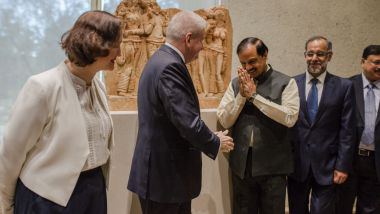
On Monday, the National Gallery of Australia returned three more antiquities to India in light of evidence – much of it first made public here – that they had been stolen from temples or archaeological sites, smuggled out of India and sold with false ownership histories by dealers now under criminal investigation.
In a ceremony in the Canberra museum’s Asian Gallery, the Australian Arts Minister Mitch Fifield handed over to his Indian counterpart Mahesh Sharma two sculptures purchased from the disgraced Manhattan antiquities dealer Subhash Kapoor, who is currently standing trial in Chennai, India for his role as the alleged mastermind of an international smuggling ring.
A third sculpture, a Kushan-era sculpture of the Seated Buddha purchased from Manhattan antiquities dealer Nancy Wiener and once a centerpiece of the Australian collection, is being quietly returned out of the public eye. We first revealed the sculpture’s false ownership history in February 2015 and wrote about it in The Australian with arts reporter Michaela Boland.
The three sculptures join the museum’s Dancing Shiva, an Ardhanarishvara from the Art Gallery of New South Wales and other objects returned in recent years, the results of a looting controversy that has shaken Australia’s museums and raised far-reaching questions about their collecting practices. Some 280 additional antiquities at the NGA alone have been identified as having a clouded ownership history by an unprecedented provenance review that is on-going.
The Australian returns underscore the growing risks faced by museums and collectors who purchased Asian antiquities in recent decades from what they believed to be respectable dealers and auction houses. As we’ve chronicled here since 2012, on-going criminal investigations by authorities in the United States, India, Pakistan, Cambodia, Thailand and beyond have slowly unraveled the transnational smuggling networks that supplied those dealers.
Sources hint that the sweeping consequences of those investigations will soon become far clearer. Monday’s Australian returns, therefore, are best understood as the end of the beginning phase of those investigations, not the end.
Kushan Buddha
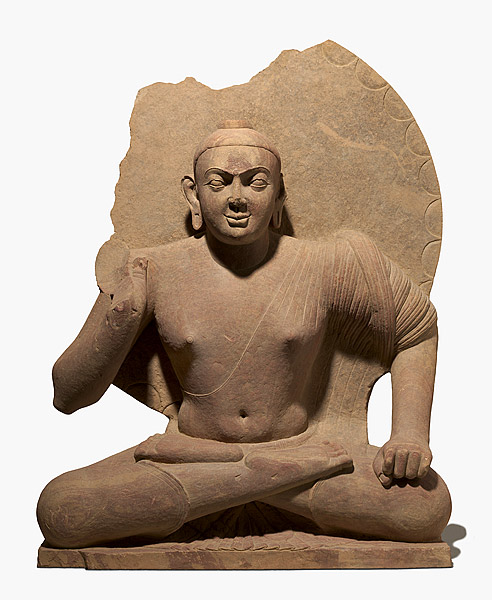 The Kushan sculpture of a Seated Buddha was likely returned out of the public eye on Monday because it no longer belongs to the museum. In March 2015, the museum announced that it had returned it for a refund to Nancy Wiener, the New York owner of the Wiener Gallery who sold the statue in 2007 for $1.08 million. Wiener, in turn, agreed to “donate” it to India.
The Kushan sculpture of a Seated Buddha was likely returned out of the public eye on Monday because it no longer belongs to the museum. In March 2015, the museum announced that it had returned it for a refund to Nancy Wiener, the New York owner of the Wiener Gallery who sold the statue in 2007 for $1.08 million. Wiener, in turn, agreed to “donate” it to India.
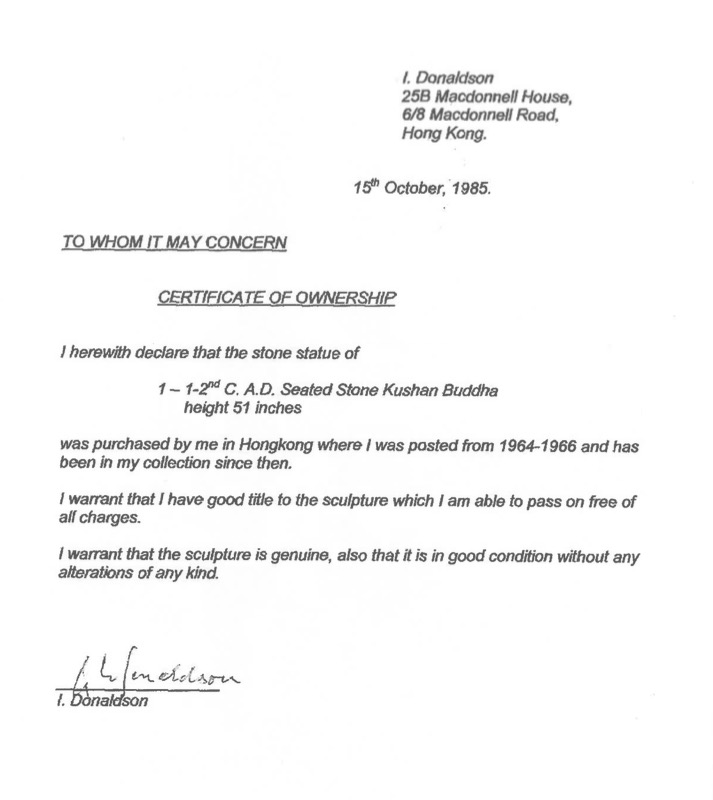
At the time of the sale, Wiener said the sculpture had belonged to an Englishman named Ian Donaldson, who claimed to have purchased it while posted in Hong Kong between 1964 and 1966. She provided the museum with a 1985 Certificate of Ownership signed by Donaldson. It was the only record of sculpture’s ownership history, but the museum did not attempt to contact Donaldson. Instead, the NGA obtained a search certificate from the Art Loss Register saying the sculpture was not in its database of stolen objects. As we’ve noted in the past, such declarations are largely useless for antiquities, yet that was the extent of the due diligence the museum conducted.
I first raised questions about the Buddha in 2012, after a source contacted me suggesting the statue’s ownership history had been falsified. The NGA eventually released documents supporting that claim and belatedly contacted the expert who had first authenticated the sculpture, Donald Stadtner. Stadtner raised further questions about the sculpture’s origins, claiming in an email to museum officials that British collector Douglas Latchford had boasted in a meeting that he had “found Nancy a provenance” for a related Kushan Buddha that Wiener sold to Singapore’s Asian Civilizations Museum. Through his attorneys, Latchford has denied ever meeting Stadtner.
The return of the NGA’s Seated Buddha will put increased pressure others to reveal the ownership history of similar objects. Singapore’s Asian Civilizations Museum has refused to disclose the provenance that Wiener provided for a very similar sculpture of a Seated Buddha.
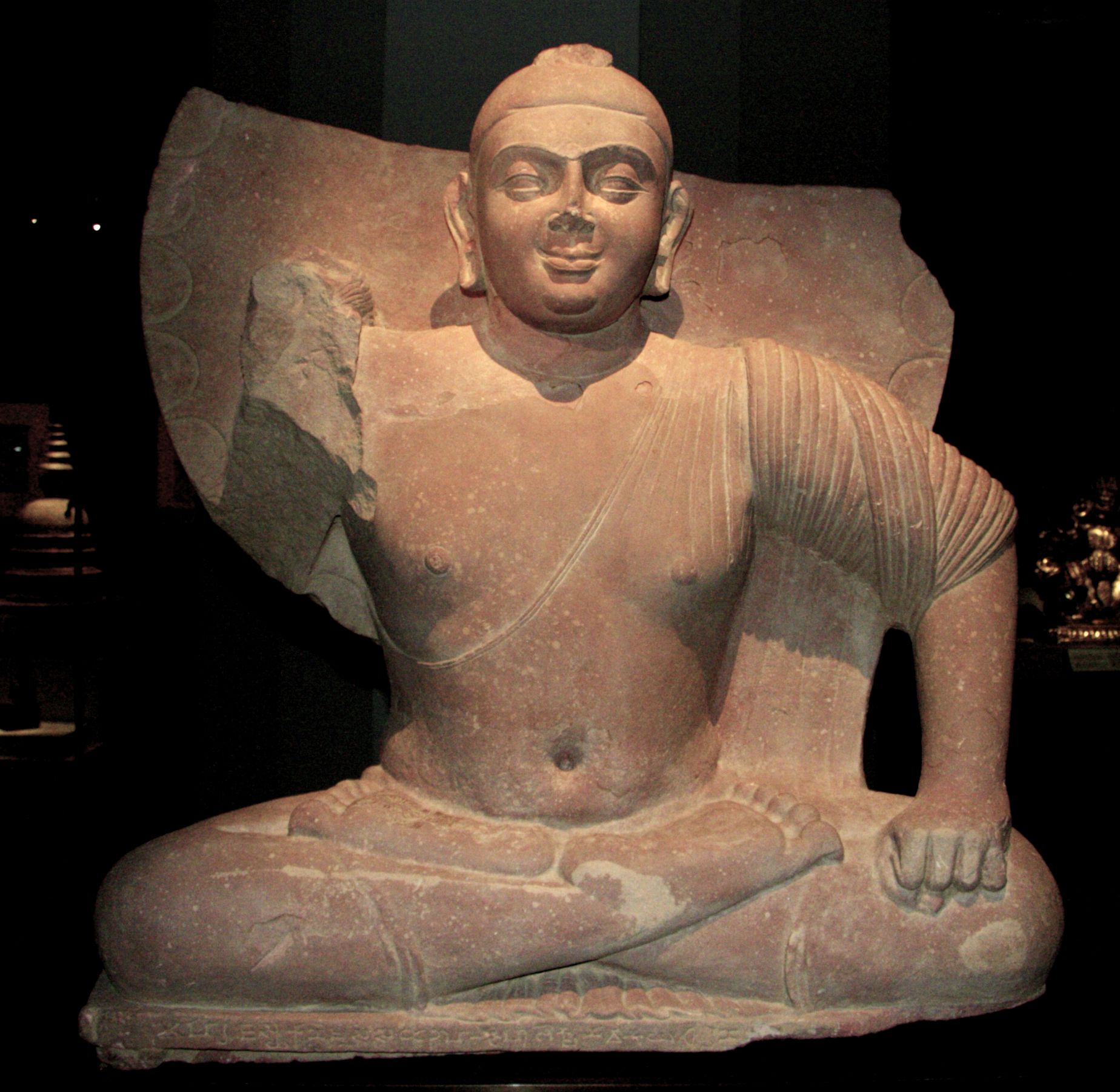
Wiener has displayed images of a third Kushan Buddha on her gallery’s website. The current location of that Buddha is not known. Wiener has not responded to repeated requests for comment in the past.
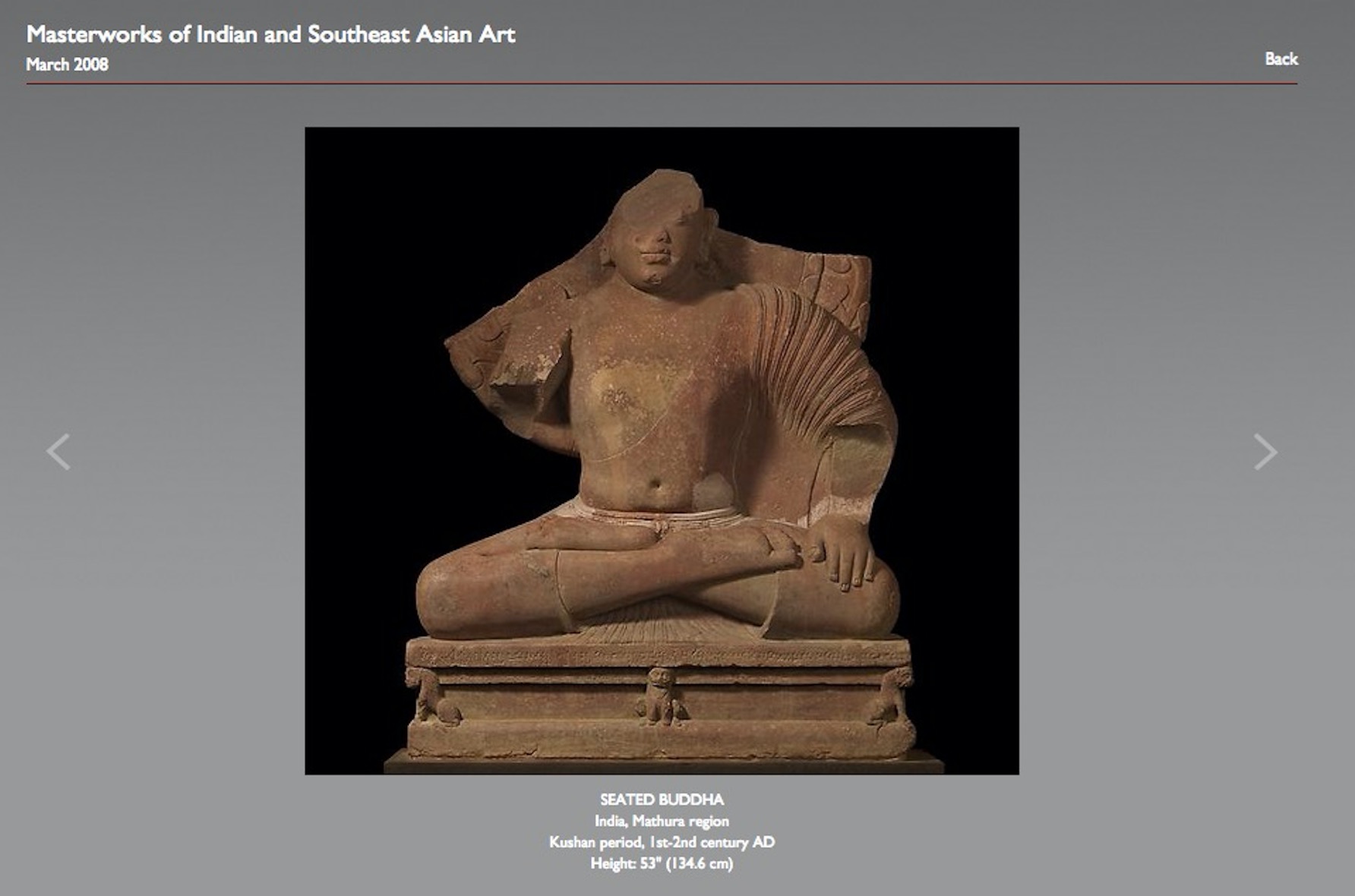
Another similar Buddha is on display at the Carlos Museum at Emory University. That Seated Buddha was acquired as a gift of the Nathan Rubin-Ida Ladd Family Foundation, which is known to have acquired objects from Kapoor.
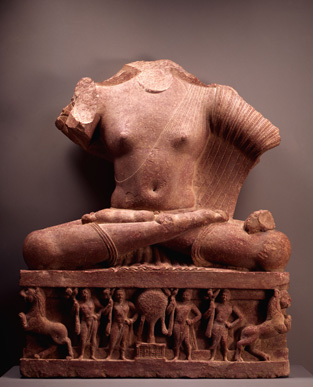
Kapoor Objects
The two other objects returned Monday are both from Subhash Kapoor and were linked to objects stolen from Indian temples by researcher Vijay Kumar of the Indian Pride Project.
In 2005, Kapoor sold both objects to the NGA for $1.5 million. One was an 1800-year-old limestone carving depicting a scene from the life of Buddha.
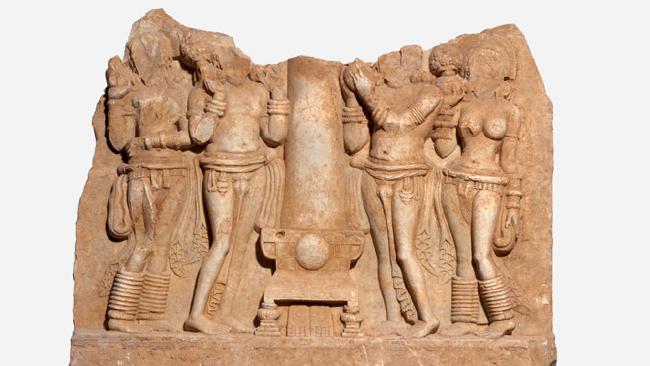
Kapoor told the museum the sculpture of the Buddha’s life had been in a private Japanese collection until 1999. But in July, we published this photo of the showing the unrestored sculpture as it appears in Kapoor’s archives, soon after it was stolen by thieves:
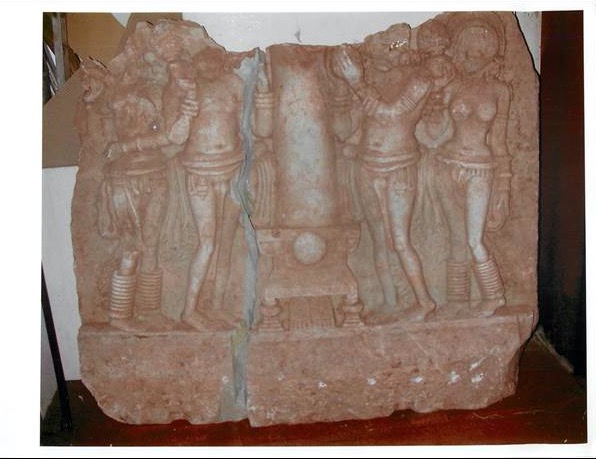
The second Kapoor object due to be returned in the ceremony Monday was a 1000-year-old stone goddess Pratyangira, or Lion Lady. Kapoor claimed the sculpture had been in the collection of his onetime girlfriend Selina Mohamed since 1990. But as we first reported in July 2016, photos and records found in Kapoor’s files show the Pratyangira was in Mumbai, India in 2002.
Kumar has linked the object to Vriddhachlam, the same temple that the Art Gallery of New South Wales Shiva was taken from.
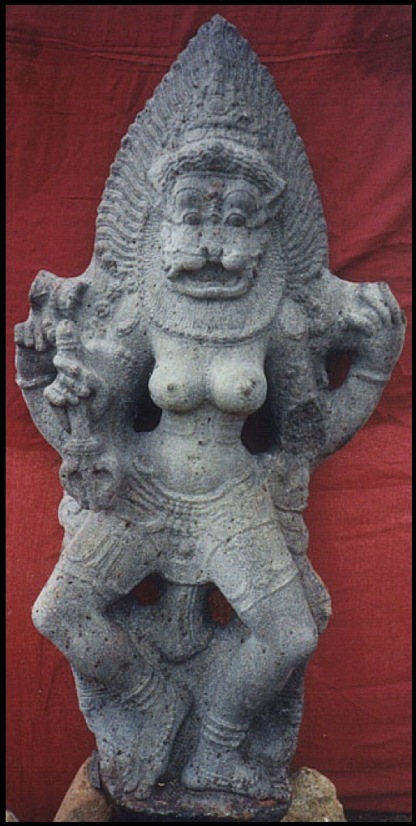
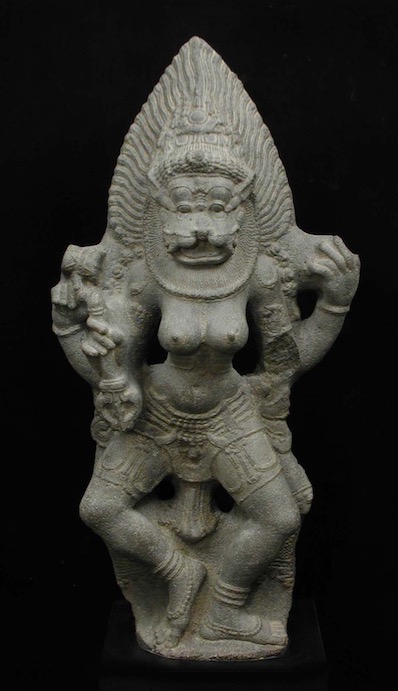
Investigators believe Kapoor obtained the two objects from a Chennai art dealer named Deena Dayalan, who has operated an art gallery there since 1965 and is suspected of being a major player in the theft and smuggling of antiquities from the region. Indian authorities raided Dayalan’s properties in July and seized substantial evidence that may have led to Monday’s returns.
The Missing Link: Subhash Kapoor’s Suppliers in India Are (Finally) Getting Rolled Up
Update September 2016: Indian media report that a temple thief who worked for Deena Dayalan has been accused of murdering a fellow thief after a dispute over 13 idols they took from a temple in 2005.
In a series of aggressive police raids over the past month, Indian authorities have disrupted a large network of alleged thieves and smugglers that for decades has plundered ancient temples from Chennai to Mumbai to supply the international art market.
The raids started on May 31st with the arrest of three men at a Chennai warehouse (or godown, in the Indian parlance). The men were employees of an 84-year old art dealer named Deena Dayalan, who has operated a Chennai art gallery since 1965. Indian and American authorities believe Dayalan has long been a major player in the theft and smuggling of antiquities from South India.
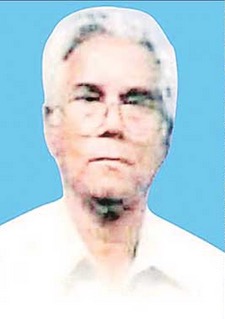
Deena Dayalan, via Indian Express
Dayalan disappeared after the raid, but turned himself in a few days later. He is said to have confessed during an interrogation and listed his associates and storage facilities across India. Subsequent raids on his properties uncovered hundreds of artifacts, including 49 bronzes, 71 stone carvings and 96 paintings and hundreds of smaller objects including ivory and wood carvings, lamps, figurines and ornamental pillars.
As reported by Frontline, The Hindu newspaper’s weekly magazine, policemen entering Dayalan’s house were stunned by the scope of his haul:
“It looked like a temple,” one investigator told Frontline. “Besides the idols and artefacts, there were pamphlets and books on temple idols and archtecture. The pillars of his house could be from some old temples. There were wooden sculptures and two elephant heads at the entrance,” said an officer.
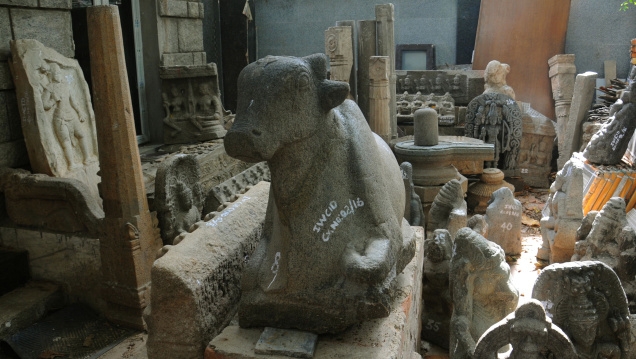
The raid was not Dayalan’s first run-in with the law. Frontline reported the dealer was accused of being behind the 2005 break-in at the ancient Sri Narum Poonathar Temple at Paluvoor village in Tirunelveli, where 13 bronze idols were stolen. After the theft, an accomplice was murdered in a dispute over efforts to extract gold from two-and-a-half-foot bronze Nataraja, which was sawn in half in the process. Dayalan was released on bail, and the case is on-going.
UPDATE 7/4/16: The Tamil Nadu Idol Wing has seized 200 objects from Lakshmi Narayanan, an associate of Dayalan. Authorities found 56 were metal idols, 103 stone idols, and 47 temple vahanas (decorative platforms used to carry the deity in processions), The Hindu reports. Narayanan was arrested and will face charges of idol theft.
 The police raids have now spread beyond Tamil Nadu are likely to continue in the coming weeks that authorities unravel the smuggling network and sort through voluminous evidence. Authorities have identified the courier service that Dayalan used to transport objects within India and seized his laptop, a desktop computer and storage drives. He allegedly labeled his stolen artifacts as modern handicrafts before they were smuggled out of India through Mumbai, where an unnamed “boss” in the illicit trade remains at large.
The police raids have now spread beyond Tamil Nadu are likely to continue in the coming weeks that authorities unravel the smuggling network and sort through voluminous evidence. Authorities have identified the courier service that Dayalan used to transport objects within India and seized his laptop, a desktop computer and storage drives. He allegedly labeled his stolen artifacts as modern handicrafts before they were smuggled out of India through Mumbai, where an unnamed “boss” in the illicit trade remains at large.
The investigation promises to give investigators what one Indian paper called “a glimpse of the man’s murky business with several smuggling cartels across the globe.” As The Hindu noted in an editorial, “The meticulously organised nature of this shadowy business hints at the deep and vast network of idol thieves who have plied their trade across not only Tamil Nadu but numerous other Indian States and even broader territories of South and South East Asia.”
The Kapoor Link
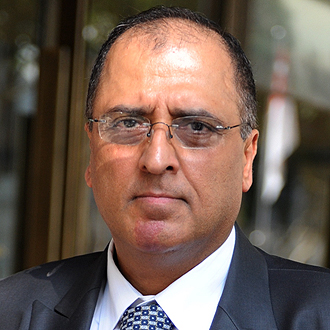 Investigators are still looking for links between Dayalan and one of his prominent American clients: Subhash Kapoor, the Manhattan antiquities dealer now standing trial in India for selling stolen antiquities to museums around the world. “We have not got clinching evidence to prove [his] link with the international idol smuggler Subhash Kapoor,” one investigator told the Times of India.
Investigators are still looking for links between Dayalan and one of his prominent American clients: Subhash Kapoor, the Manhattan antiquities dealer now standing trial in India for selling stolen antiquities to museums around the world. “We have not got clinching evidence to prove [his] link with the international idol smuggler Subhash Kapoor,” one investigator told the Times of India.
We can help: The following document links Dhayalan to Kapoor and hints at the extensive business relationship they are believed to have had.

The document records Dayalan’s 2007 request for a payment of USD $11,400 from Kapoor’s Nimbus Import & Export through Selva Export, one of the Chennai export companies they used to transport artifacts. It is still unclear whether that amount was paid, what object(s) were purchased for the sum, and where those objects are today.
 But authorities have already identified Dayalan as the source of one stolen Kapoor object that has already been returned to India: The Art Gallery of New South Wales‘ sculpture of Ardhanarishvara, whose origins we revealed in 2013.
But authorities have already identified Dayalan as the source of one stolen Kapoor object that has already been returned to India: The Art Gallery of New South Wales‘ sculpture of Ardhanarishvara, whose origins we revealed in 2013.
The AGNSW purchased the sculpture for $300,000 after Kapoor provided documents claiming it had left India in the 1970s. But Vijay Kumar of the India Pride Project identified images that showed the sculpture in situ at the Vriddhachalam temple at least four years after 1970. A subsequent police investigation concluded it had been stolen in 2002 by Dayalan and replaced by a knockoff that villagers continued to worship.
Dayalan is believed to have supplied Kapoor with a number of objects from South India.
As Michaela Boland reported Sunday in The Australian, Dayalan is believed to have supplied Kapoor with two other objects that landed in the National Gallery of Australia: an 1800-year-old limestone carving depicting a scene from the life of Buddha, and a 1000-year-old stone goddess Pratyangira, purchased together from Kapoor in 2005 for $1.5 million. 
Kapoor told the museum the sculpture of the Buddha’s life had been in a private Japanese collection until 1999. But this photo, found in Kapoor’s archives, shows the unrestored sculpture above soon after it was stolen by thieves:
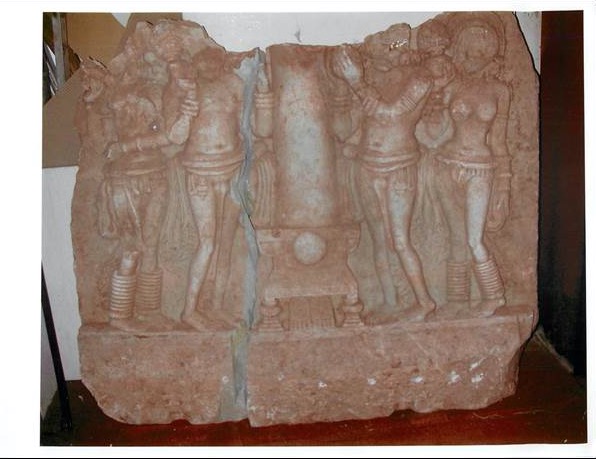
A similar tale emerges on the NGA’s Pratyangira. Kapoor claimed it had been in the collection of Selina Mohamed (his onetime girlfriend) since 1990. But photos and records found in Kapoor’s files show the Pratyangira was still in Mumbai, India in 2002.
Below at left we see the NGA’s Pratyangira as offered in a Kapoor catalog, and at right the same sculpture before it left India. Note the identical missing segments from the figure’s left elbow.
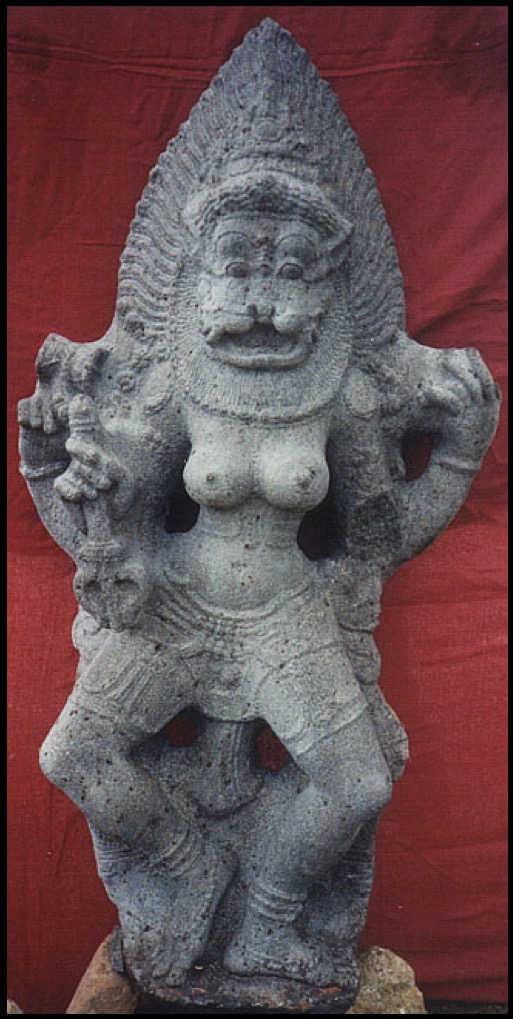

Amaravati Objects
Investigators believe Dayalan may have been behind looting of material from Amaravati, an important archeological site in Andhra Pradesh, where Dayalan grew up. Items seized from his warehouses include Amaravati architectural fragments.

Dayalan may well have been the source of Amaravati fragments that Kapoor sold to the Asian Civilizations Museum in Singapore.

As we wrote in 2014, Kapoor sold the ACM a 3rd Century limestone fragment from Amaravati in October 1997 for $22,500. His accompanying description suggests he had detailed knowledge of the find spot:
“Examples from the Amaravait stuppa are extremely rare to find,” he wrote. “This particular piece does not come from the stuppa proper, but from the outer rail copings that surrounded the stuppa. It is an exceptional example in both its size and in its illustrative qualities…The iconography of this fragment makes this a most interesting piece from the Amaravati area.”
Long Time Coming
The Indian raids are long overdue. Records show American authorities provided detailed evidence about Kapoor’s Indian suppliers as far back as 2014. India’s failure to act on those leads, despite repeated urging from American authorities and others, has been one of several troubling signs in the long delayed criminal trial of Kapoor.
As Kumar recounted in an article about the investigation by ICE U.S. Special Agent Brent Easter: “For too long the red tape of Indian Bureaucracy and the ill equipped custodians have sent him on wild goose chases – including multiple weeks in hot and sultry India, with promises of arrests of the bad guys. Frustrating, when he has done all the hard work and with irrefutable proof of the bad guys shipping documents, email exchanges and bank transfers to see the patchy attempts in delaying and letting the actual crooks off the hook.”
It is likely no coincidence that the Indian raids were launched just days before U.S. Attorney General Loretta Lynch announced the return of 200 looted antiquities to India during the state visit of Prime Minister Narendra Modi. The returns, many of which had been seized from Kapoor or his clients, may have been used as leverage with India to ensure Kapoor’s suppliers were nabbed. (On the right below is the Toledo Ganesh, which Kumar first revealed as looted in a 2013 post.)
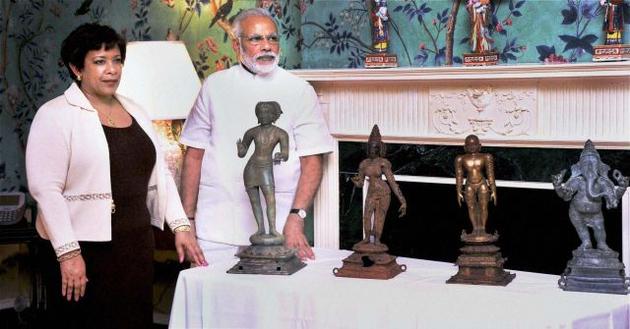
The raids have also underscored the need to expand India’s domestic enforcement efforts. The country’s only dedicated art police is the Tamil Nadu idol wing, led by Inspector General A G Pon Manickavel, is now chasing leads across India and international borders. The country desperately needs to develop a national police force dedicated to protecting its oft-purloined cultural heritage.
Government agencies should also work more closely with civil society groups like Kumar’s India Pride Project, which has worked tirelessly over the past years to identify stolen antiquities and bring them home, often while cajoling government officials to do more.
The willingness of Indian officials to crack down on the illicit antiquities trade within their borders will be measured largely by the aggressiveness with which they chase the leads they have gathered from Deena Dhayalan.
Asia Week Raids: New Details on the Christie’s Seizures

This week, a series of five federal raids during New York’s Asia week led to the seizure of at least eight looted antiquities and the arrest of at least one dealer. This is the first of several posts that will discuss the alleged smuggling networks disrupted by those raids.
The Asia Week raids started on Friday at Christie’s, where federal agents seized two sculptures valued at $450,000 being offered as part of the private collection of London doctor Avijit Lahiri and his wife Bratatihis.
Court records reveal a link between the objects and a key supplier of Subhash Kapoor, the American antiquities dealer now on trial in India for his role in a global trafficking network.
Taken together, the Asia Week raids show that the 2012 seizure of Kapoor’s business records (as well as more than $100 million in looted antiquities he had in storage) have allowed investigators to identify looted antiquities being offered for sale on the American art market, much as the Medici, Becchina and Symes archives have done in recent years.
They also show that aggressive law enforcement investigations can have a meaningful effect disrupting those smuggling networks.
Rishabhanata

It is not clear where Lahiri acquired the 10th century stele of Rishabhanata (shown above.) Based on its style, the piece was likely found in Rajasthan or Madhya Pradesh, India. Christie’s stated it had been acquired in London by 1999. In 2006, Lahiri put it on consignment with the London dealers Oliver Forge and Brendan Lynch Ltd. Forge and Lynch stated it had been in London since 1989.
 Lynch has had prior run-ins with the illicit antiquities trade in India. Court records filed this week quote a confidential informant telling authorities that Lynch “traveled to India roughly twice a year in the 1980’s while working for London Sotheby’s as the head of their Indian and Islamic Department in order to meet with Vaman Ghiya (an arrested antiquities dealer in India) to select recently looted artifacts for Sotheby’s auction.” Ghiya is a notorious convicted Indian antiquities smuggler who has been described as “the Indian Medici.” In 2007, he was profiled in the New Yorker story The Idol Thief. Lynch, who admitted hiding from Indian police in Ghiya’s house, left Sotheby’s after his dealings with Ghiya were exposed, but has continued to deal in Indian and other art since the 1990s.
Lynch has had prior run-ins with the illicit antiquities trade in India. Court records filed this week quote a confidential informant telling authorities that Lynch “traveled to India roughly twice a year in the 1980’s while working for London Sotheby’s as the head of their Indian and Islamic Department in order to meet with Vaman Ghiya (an arrested antiquities dealer in India) to select recently looted artifacts for Sotheby’s auction.” Ghiya is a notorious convicted Indian antiquities smuggler who has been described as “the Indian Medici.” In 2007, he was profiled in the New Yorker story The Idol Thief. Lynch, who admitted hiding from Indian police in Ghiya’s house, left Sotheby’s after his dealings with Ghiya were exposed, but has continued to deal in Indian and other art since the 1990s.
In a statement, Forge and Lynch said they never sold the Rishabhanata: “In 2006, the Sandstone Stele of Rishabhanata was consigned to Oliver Forge and Brendan Lynch Ltd by Dr. Lahiri, a London-based collector of Indian and Southeast Asian works of art. The sculpture was not sold and was returned to Dr. Lahiri. The sculpture was exhibited on asianart.com while on consignment with the firm. Prior to the consignment, Dr. Lahiri had informed Messrs. Forge and Lynch that the sculpture was purchased by him in London in 1989.The firm has never bought from or sold an object to Subash Kapoor.” We have asked Lynch for a comment on the Ghiya allegations and will post it when we receive one.
Kapoor’s files revealed the object’s earlier history: a photo (below) of the Rishabhanata was found in a folder labeled “Shantoo,” the nick name for an alleged Indian smuggler named Ranjeet Kanwat, court records state. The image showed the sculpture sitting on a bed of straw as it looked soon after being looted.

 The first to match the Shantoo image to the Lahiri stele was Vijay Kumar, an Indian art enthusiast and blogger in Singapore who has been quietly helping authorities track down Kapoor’s looted art.
The first to match the Shantoo image to the Lahiri stele was Vijay Kumar, an Indian art enthusiast and blogger in Singapore who has been quietly helping authorities track down Kapoor’s looted art.
Two years ago Kumar recognized the Rishabhanata offered by Lynch and Forge as the same one that Shantoo had offered to Kapoor. The problem: nobody knew where the piece was at the time.
When Kumar saw the Rishabhanata appear in the Christie’s catalog for its Asia Week sale, he alerted investigators, who organized the seizure.
Smugglers and dealers “are destroying destroying context, reducing our Gods to showcase curios and funding anti social elements,” Kumar said Friday when asked about his role. Countries of origin “must realise the value of what the USA is doing and support this with arrests and prosecutions.”
Revanta and his Entourage

The second object seized from Christie’s, an 8th century panel showing Revanta and his Entourage (above), also appears to have originated with Shantoo, court records show.
Christie’s offered the piece, Lot 62, with a $300,000 estimate at its Asia Week sale, stating that it had been sold by Spink and Son auction house in London by 1999. Spink and Son has become a notorious name in recent years as the source of several looted objects, including the looted Khmer statue seized from Sotheby’s and returned to Cambodia in 2013. As Neil Brodie recently observed, Christie’s holds the original records of Spink’s Asian sales but has not released them publicly.
Kapoor’s files show the same Revanta relief was offered to him by “Shantoo” some time in the 1990s. The offer included this picture of the piece in the mud and surrounded by straw, suggesting it had recently been looted.

Notably, several pieces missing from the relief in the Shantoo image are reunited with the sculpture by the time it is offered at Christie’s. In court records, authorities suggest that these “orphan” fragments may have been held back by looters to extract a higher price or to be sold separately.
On March 15, the Lahiri sale continued despite the embarrassing seizures. The auction netted nearly $2.4 million with the buyer’s premium.
In a statement Christie’s said it had no knowledge of the illicit origins of the sculptures. “Christie’s devotes considerable resources to investigating the provenance of all objects we offer for sale,” the statement read. “This is one of the difficulties the art market faces in vetting antiquities, which is why Christie’s very much values building strong relationships with and between countries of origin, law enforcement, archeologists, and the collecting community.”
Busted: Asia Week Raids Reveal Scope of Illicit Trade in Asian Art
Federal agents raided the Nancy Wiener Gallery on Thursday, the latest move in an aggressive crack down on the trade in ancient Asian art that has targeted several leading dealers and auction houses and shaken up New York’s Asia Week art show.
Federal agents were given a court order to seize the following objects from the Wiener Gallery:

A 1st Century red sandstone Kushan Relief valued at $100,000
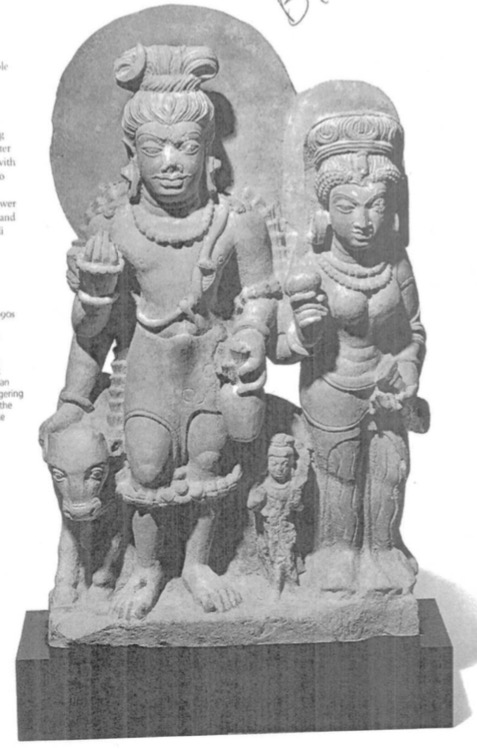
An 8th Century limestone sculpture of Shiva and Parvati valued at $35,000
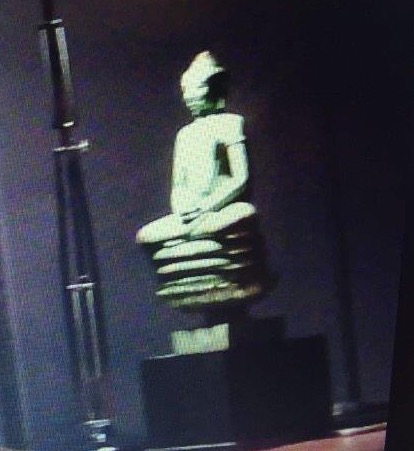
A 10th Century bronze Buddha from Thailand or Cambodia valued at $850,000
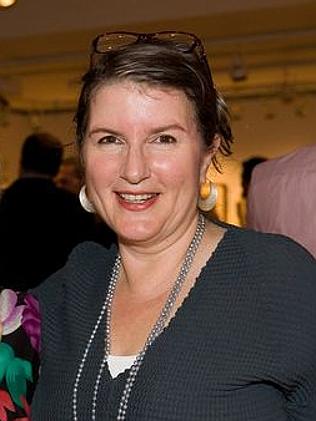 Wiener is a second generation antiquities dealer who runs one of the country’s most prestigious Asian art galleries on Manhattan’s East 74th Street. Last year we revealed her role in the sale of a Kushan Buddha with a false ownership history to the National Gallery of Australia. Wiener agreed to refund the $1.08 million purchase price to the museum, which will soon return the sculpture to India.
Wiener is a second generation antiquities dealer who runs one of the country’s most prestigious Asian art galleries on Manhattan’s East 74th Street. Last year we revealed her role in the sale of a Kushan Buddha with a false ownership history to the National Gallery of Australia. Wiener agreed to refund the $1.08 million purchase price to the museum, which will soon return the sculpture to India.
Wiener is the latest target in a series of high profile Asia Week raids that were quietly orchestrated over the past year by special agent Brent Easter at Immigration and Customs Enforcement and prosecutor Matthew Bogdanos at the Manhattan District Attorney’s Office.
The investigation, dubbed Operation Hiddon Idol, began with Subhash Kapoor, who is currently on trial in India. As we’ve covered in a series of posts since 2012, authorities seized 2,622 objects valued at more than $100 million from Kapoor’s business and storage facilities. Perhaps more importantly, federal agents secured the cooperation of former Kapoor associates and seized decades of his business records, both of which have revealed a network of antiquities looters and smugglers across Asia whose objects Kapoor sold to museums and collectors around the globe.
 In the years since the Kapoor seizures, Easter and Bogdanos have been investigating the collectors and museums who bought from Kapoor and the suppliers who smuggled looted antiquities for him. Easter’s work on the case is highlighted in this short documentary by director Jason Kohn.
In the years since the Kapoor seizures, Easter and Bogdanos have been investigating the collectors and museums who bought from Kapoor and the suppliers who smuggled looted antiquities for him. Easter’s work on the case is highlighted in this short documentary by director Jason Kohn.
This week’s raids at Asia Week netted 8 antiquities valued at more than $4 million seized in five separate raids. Taken together, they offer dramatic evidence that Kapoor’s corrupt suppliers were selling looted objects to other top dealers in Asian art.
We’ll have more details on the Asia Week seizures in the days ahead.
The Crennan Report: The NGA’s Ex Post Facto Due Diligence Finds 22 “Questionable” Asian Antiquities

In an unprecedented review of its Asian art collection, the National Gallery of Australia has determined that 22 of the 36 objects examined to date have “insufficient or questionable provenance documentation.”
Among the problematic objects are 14 that came from Manhattan dealer Subhash Kapoor’s Art of the Past, including the $5 million Dancing Shiva returned to India by Prime Minister Tony Abbott last year and several others we’ve highlighted in previous reports. Also highlighted in the report is the museum’s Kushan Buddha, which our report last year revealed had been sold the museum with a false ownership history by Manhattan dealer Nancy Wiener. Wiener agreed to refund the $1.08 million purchase price, and the NGA will return the sculpture to India this year.
Eight other questionable objects came through Wiener and another Manhattan Asian art dealer, Carlton Rochell; the Swiss dealer/collector George Ortiz; and auction houses Spink and Son and Christie’s, among other familiar names. We’ll detail those objects in a subsequent report.
The ex post facto review is part of the museum’s Asian Art Provenance Project, which in the wake of an international looting scandal aims to assess and publish the collecting histories of all 5,000 art objects in the museum’s collection. It was sparked in part by our series of reports starting in June 2013 that revealed several of the museum’s prized Asian antiquities had been looted from Indian temples and sold by Manhattan dealer Subhash Kapoor with false ownership histories.

While years late, the Australian review goes beyond what American musuems undertook in the wake of similar looting scandals a decade ago, and sets an important new standard for due diligence: independent review and complete transparency with provenance.
Notably, the NGA asked an outside lawyer, Former Justice of the High Court of Australia Susan Crennan, to independently review and publish the project’s initial conclusions. In her 89-page report, Crennan reviews the relevant international laws and treaties before adopting a clear standard of review:
- does the object have a credible chain of ownership?
- the object was outside its probable country of origin before 1970, or was legally exported from that country after 1970?
For 22 of the objects, her answer was no.

On several occasions she cited (without credit) images first published here showing NGA objects the in process of being smuggled out of India to Kapoor. “Dr [Michael] Brand, who supervised the [Getty’s return of 40 looted objects], stated that such photos were the most convincing pieces of circumstantial evidence of theft,” Crennan noted.
Sprinkled throughout her report is commentary that serves as common sense advice to those conducting their own due diligence:
- “Circumstantial evidence can be as compelling as direct evidence, especially when several pieces of circumstantial evidence all support a particular conclusion.”
- Due diligence should include “direct contact with any living consignor, or previous owner, particularly to elicit the date and circumstances of the export of a work from a country of origin. The absence of such details increases the risk that the [acquirer] will not obtain good title from a vendor.”
- Even “reputable” dealers should be treated with skepticism, and the word of a dealer should not be taken as fact unless it can be independently corroborated.
- Buyers should “require revelation of the identity of any consignor, or previous owners of a work of art (which can be conveyed confidentially). They might also require direct contact with any consignor, or previous owner, so as to be satisfied of the date and circumstances of any export of an object from a country of origin.” Auction houses in particular should be pressed to reveal their consignors.
- “Listing such objects on a dedicated website achieves several desirable aims: it constitutes notice to the whole world (including any true owner) of a museum’s custody and possession of an object; it encourages exchange of provenance information between museums, especially those with objects of shared provenance; and it invites holders of a relevant interest, or relevant information, to come forward with that information.”
Buyers of antiquities would be wise to learn from the National Gallery of Australia’s example and follow these procedures before buying ancient art, not years later.
A copy of Crennan’s complete report can be found here.
Ball State’s Kapoor Return Reveals New False Provenance
 On Monday, Immigration and Customs Enforcement agents recovered a Chola period bronze from Ball State University’s Owsley Museum, marking yet another trail in the path of stolen Indian artifacts sold by dealer Subhash Kapoor.
On Monday, Immigration and Customs Enforcement agents recovered a Chola period bronze from Ball State University’s Owsley Museum, marking yet another trail in the path of stolen Indian artifacts sold by dealer Subhash Kapoor.
In April 2005, the Indiana museum bought the Festival Bronze of Shiva and Parvati from Kapoor for $100,000, records show. Kapoor presented paperwork showing it had been in a private collection since 1969.
But images seized from Kapoor show he only acquired the bronze in 2004. At the time, it was covered in dirt and missing several pieces, as shown in the photo below.

Questions about the bronze were first raised by our friend Vijay Kumar, who wrote about the sculpture in the Times of India in July 2015.
The temple it was stolen from has yet to be identified. As Kumar noted, that the base of the statue has an inscription in Tamil that reads: “Thipampaapuram Sivigai Naayagar.”
“There are a few temples in Tamil Nadu that have names such as Thirupampuram, Thipamburam and so on…It was sold in 2005, the same time when Sripuranthan and Suthamalli were looted. With the help of the public, the authorities including the police should take all efforts to bring home this statue.”
After museum officials were informed about Kumar’s article, they contacted the Indian Consulate in Chicago and cooperated with federal agents during their investigation. “Homeland Security Investigations has presented convincing evidence that the work was stolen and its documentation falsified,” said museum director Robert La France.
As we’ve reported, Kapoor and his staff often used the name of his girlfriend and other acquaintances to create a false ownership for recently stolen antiquities. The Ball State case reveals a new name used by Kapoor: Leo Figiel, a collector of Indian art who died in 2013 2004. The Peabody Essex Museum, which recently returned a Kapoor object, acquired Figiel’s collection of antique Indian bronzes in 2006.
Figiel provided Kapoor with this false letter claiming he acquired the bronze from “a European collection in 1969.” It was not the only Kapoor object for which Figiel provided a false provenance, as we’ll show in the coming weeks.

Posted in News
Tagged Ball State University, India, Leo Figiel, Subhash Kapoor, Vijay Kumar
Shiva Goes Home: Australia’s Prime Minister Returns Looted Kapoor Idols to India

On Friday, Australia’s Prime Minister Tony Abbott will return two looted idols seized from Australian museums during a meeting with his Indian counterpart Narendra Modi in New Delhi.
Abbott will personally deliver the National Gallery of Australia‘s $5 million Dancing Shiva and the Art Gallery of New South Wales‘ $300,000 Ardhanarishvara to Modi as a “gesture of good will” at a state reception at the Indian presidential palace, the Australian’s Michaela Boland reported in Friday’s paper (front page seen above.)
As we first revealed here a year ago, both objects were stolen from temples in India and later sold to the museums by Manhattan dealer Subhash Kapoor, who, his gallery manager has admitted, created falsified ownership documents to hide their illicit origins.
The Australian returns mark the first major repatriations in the Kapoor case, but are unlikely to be the last. Dozens more Kapoor objects acquired by the Australian museums were sold with false ownership histories similar to those used with the returned objects. Several will likely play a prominent role in Kapoor’s criminal trial in Chennai, India, which has been on hold pending the return of the NGA’s looted Shiva. (below)
Meanwhile, Kapoor’s international network of looters and smugglers is still being mapped by authorities in the United States, who have already seized over $100 million in art from the dealer’s Manhattan gallery and storage facilities. Federal investigators in the United States are methodically working through mountains of evidence seized from Kapoor, probing his ties to a number of American and foreign museums that did business with the dealer. Indian authorities, meanwhile, are considering a broader campaign to reclaim stolen antiquities from foreign institutions.
 Over the past two years, we’ve traced hundreds of suspect Kapoor objects to museums around the world. To date, the Kapoor case has received the most attention in Australia, whose National Gallery for months stonewalled press and government inquiries and dismissed mounting evidence before agreeing to take the stolen idol off display. The Art Gallery of New South Wales took a slightly more proactive approach, releasing the ownership history that Kapoor supplied for its sculpture of Ardhanarishvara (left.) Soon after, Indian art blogger Vijay Kumar identified the temple from which the sculpture was stolen.
Over the past two years, we’ve traced hundreds of suspect Kapoor objects to museums around the world. To date, the Kapoor case has received the most attention in Australia, whose National Gallery for months stonewalled press and government inquiries and dismissed mounting evidence before agreeing to take the stolen idol off display. The Art Gallery of New South Wales took a slightly more proactive approach, releasing the ownership history that Kapoor supplied for its sculpture of Ardhanarishvara (left.) Soon after, Indian art blogger Vijay Kumar identified the temple from which the sculpture was stolen.
The idols have been in the Australian government’s possession for months, but their fate remained unclear until today. The According to The Australian, Abbott decided during a July dinner with George Brandis, Australia’s Attorney General and Arts Minister, to present the idols to Modi during his two-day state visit to India. “Brandis told him the issue was a potential problem in the relationship between the nations and Mr Abbott said returning the statues would be an important statement of goodwill towards the Indian Prime Minister, elected to office in May,” the newspaper reported.
Underscoring the diplomatic importance of the returns, Abbott reportedly wanted to have his presidential plane transport the objects directly but they were too heavy and were dispatched on Wednesday by jumbo jet instead.
Meanwhile, the National Gallery officials who played a key role in acquiring the Shiva – despite the warnings of their own attorney – are quietly exiting the scene. Curator Robyn Maxwell, who handled the negotiations with Kapoor, retired quietly last month, the Australian reported. Director Ronald Radford will retire this month, his legacy tarnished by his mishandling of the case. The Art Gallery NSW’s Michael Brand, who has taken a more open approach to looting investigations in Australia and previously at the Getty, has been mentioned as a possible successor.
UPDATED > Singapore Sling: The Asian Civilizations Museum Paid Kapoor More Than $1 million
UPDATE 6/15/15: The Asian Civilizations Museum has agreed to return its looted sculture of Uma, according to Indian press reports. Twenty eight additional Kapoor objects at the museum remain under review.
UPDATE 3/20/15: The Asian Civilizations Museum has filed a lawsuit against Subhash Kapoor in New York City seeking repayment of $1.4 million it paid him for antiquities with falsified ownership histories. As noted earlier when Australia’s NGA took a similar step, such lawsuits are unlikely to prevail given Kapoor’s on-going criminal trial in India.
UPDATE: In response to this report, the Asian Civilizations Museum confirmed our accounting and released information on a few objects we missed, including six additional paintings purchased for $100,000 and a 10th century stone Nandi purchased for $55,000. That brings the total paid to dealer Subhash Kapoor to more than $1.3 million. The museum has yet to release any information on the provenance for the ancient objects.
 Singapore’s Asian Civilizations Museum bought more than $1 million of art from disgraced Manhattan antiquities dealer Subhash Kapoor, according to business records from Kapoor’s Art of the Past gallery.
Singapore’s Asian Civilizations Museum bought more than $1 million of art from disgraced Manhattan antiquities dealer Subhash Kapoor, according to business records from Kapoor’s Art of the Past gallery.
Invoices that Kapoor sent to the ACM between 1997 and 2010 detail more than two dozen objects he sold, including nine antiquities of unclear provenance. (Kapoor also sold Indian manuscripts and paintings that to date have not be the subject of law enforcement investigations. Our complete Kapoor coverage here.) Most of the invoices were directed to the ACM’s former senior curator for South Asia, Dr. Gauri Krishnan. Krishnan is now director of the Indian Heritage Centre at Singapore’s National Heritage Board. The ACM did not respond to a request for comment.
 Last December we reported that the ACM’s sculpture of Uma Parameshvari was stolen from the Sivan Temple in India’s Ariyalur District in 2005 or 2006, according to the court records filed with the guilty plea of Kapoor’s gallery manager Aaron Freedman.
Last December we reported that the ACM’s sculpture of Uma Parameshvari was stolen from the Sivan Temple in India’s Ariyalur District in 2005 or 2006, according to the court records filed with the guilty plea of Kapoor’s gallery manager Aaron Freedman.
In January, the ACM acknowledged it had purchased a total of 30 objects from Kapoor, who currently stands trial in India for trafficking 18 idols stolen at his request from local temples. The ACM did not name the objects, detail their provenance or disclose the price the museum had paid for them.
Now we can.
 In October 1997, Kapoor billed the ACM $22,500 for a 3rd Century limestone fragment from Amaravati, South India. “Examples from the Amaravait stuppa are extremely rare to find,” Kapoor wrote in text accompanying the sale. “This particular piece does not come from the stuppa proper, but from the outer rail copings that surrounded the stuppa. It is an exceptional example in both its size and in its illustrative qualities…The iconography of this fragment makes this a most interesting piece from the Amaravati area.”
In October 1997, Kapoor billed the ACM $22,500 for a 3rd Century limestone fragment from Amaravati, South India. “Examples from the Amaravait stuppa are extremely rare to find,” Kapoor wrote in text accompanying the sale. “This particular piece does not come from the stuppa proper, but from the outer rail copings that surrounded the stuppa. It is an exceptional example in both its size and in its illustrative qualities…The iconography of this fragment makes this a most interesting piece from the Amaravati area.”
 Later that same month, Kapoor sold the ACM a copper 11th Century Standing Buddha from Nagapattinam, Tamil Nadu for $15,000. “Nagapattinam was an important center for Buddhism in South India,” he noted in the text. “Material from this area is extremely rare to find, and especially in such fine condition. The Los Angeles County Museum of Art has an example which is slightly larger, but remains in a much inferior condition (vol.2 fig.140b). This example, though, is extremely crisp and well articulated.”
Later that same month, Kapoor sold the ACM a copper 11th Century Standing Buddha from Nagapattinam, Tamil Nadu for $15,000. “Nagapattinam was an important center for Buddhism in South India,” he noted in the text. “Material from this area is extremely rare to find, and especially in such fine condition. The Los Angeles County Museum of Art has an example which is slightly larger, but remains in a much inferior condition (vol.2 fig.140b). This example, though, is extremely crisp and well articulated.”
In February 1998, Kapoor sold the ACM an 11th Century sandstone Crouching Lion (above) from Kanoj, Uttar Padesh for $35,000 and an 11th century stone Goddess Camunda (right) from Rajshahi, Bangladesh priced at $25,000. After a $5,000 discount, the total invoice was for $55,000. The goddess had previously been published in Leaves of the Bodhi Tree (#24).
That same month, Kapoor billed the ACM $9,500 for Hindoo Costumes, an album of 14 paintings from South India. Kapoor said the previous owner of the album was Sofia Anna Woolfe. In March 1999, Kapoor sold the ACM two 19th century watercolors from Tanjore for $6,000.
An Art of the Past invoice dated April 2002 shows the ACM bought three ancient rattles from Kapoor for $10,000. The rattles (above) depict a seated man with bare belly, a boy seated with ball, and a seated man.
In July 2006, Kapoor provided ACM with a letter of provenance for a late 18th century altar from Goa with the Virgin Mary and Christ Child. The letter claims the altar had belonged to the parents of Selina Mohamed, Kapoor’s girlfriend. Mohamed claimed her parents acquired the altar in the 1960s and gifted it to her in 1992. (For reasons that are not clear, Kapoor did not send an invoice for the altar until February 2009, when he billed the ACM $135,000.)

Mohamed was indicted by US authorities in December 2013 on four counts of possession of stolen property and one count of conspiracy. Court records allege she fabricated false ownership histories for dozens of objects sold by Kapoor.
In February 2007, Kapoor sold the ACM the 11th century bronze Chola sculpture of Uma Parameshvari mentioned above. The price, after a $100,000 “discount,” was $650,000. The Uma had appeared in Art of the Past’s 2006 catalog. The ACM’s former curator Gauri Parimoo Krishnan has described the sculpture as one of the museum’s most prized artifacts, and it is featured prominently in museum promotional materials.
In a separate invoice that month, Kapoor specified the price ACM paid for ten additional objects:
|
1 |
Jina Rishabhanatha, M5378 South India, late 18th – early 19th century |
25,000.00 |
|
2 |
Guru Garanth Sahib, M5831 Manuscript Punjab, Lahore, 19th century |
15,000.00 |
|
3 |
Folio from a Mahabharata Series, P2458 South India, Seringpatnam, circa 1670Gouache and gold on paper |
25,000.00 |
|
4 |
Adulation of Shri Nath-ji P2727 Rajasthan, Nathdawara, circa 1870 |
12,000.00 |
|
5 |
The Siege of Lanka P3009 Kangra, ca. 1820 Gouache and gold on paper |
75,000.00 |
|
6 |
Rama and His Army Crossing to Lanka P3014 Kangra, ca. 1820 Gouache and gold on paper |
75,000.00 |
|
7 |
Guru Nanak Dev with Bala and Mardana P0811 Deccan, circa 1700-1720 Gouache and gold on paper |
9,000.00 |
|
8 |
Ram,Lakshman, Sita in River P3010 |
50,000.00 |
|
9 |
Ram Lskshman Leaving P3012 |
60,000.00 |
|
10 |
Mica Muharram Procession P1847 Delhi or Jaipur 19th century |
3,500.00 |
|
Total |
349,500.00 |
|
|
Discountover 31% |
109,500.00 |
|
|
Final Total |
240,000.00 |
Also in February 2007, Kapoor provided the ACM with a guarantee for the authenticity and provenance “of all artwork sold.” “If in the future the verity of either their provenance or authenticity is legally questioned and found to be incorrect, I nearby promise to reimburse the Asian Civilization Museum for the cost paid…” In April 2007, Kapoor billed the ACM $12,381 for the customs duties for the shipment of nine paintings an one manuscript, most likely the ones listed above.
In Dec, 2009, Kapoor billed the ACM 37,500 for three $30,000 for two watercolors on gold paper. (Change reflects statement by ACM.)
The total value of the ACM’s acquisitions from Kapoor: $1,328,250.
Given the ACM’s extensive dealings with Kapoor, the Singapore museum should immediately release the provenance documents for all the antiquities it acquired from the dealer and proactively reach out to Indian and American investigators.
Our gratitude to Vijay Kumar for supplying several images of the Kapoor objects on display in the ACM. Readers can follow developments in the Kapoor case at Kumar’s website Poetry in Stone.
Posted in News
Tagged Asian Civilizations Museum, Gauri Krishnan, Selina Mohamed, Singapore, Subhash Kapoor, Vijay Kumar
Reckless: In Pursuit of Shiva, the National Gallery of Australia Ignored the Advice of Its Attorney
The National Gallery of Australia ignored the advice of its own attorney when buying the $5 million bronze sculpture of Shiva, according to a damning confidential document uncovered by the Australian documentary program Four Corners, which aired an hour-long investigation of the case on Monday.
The Shiva was taken off display Wednesday, some ten months after we first published evidence that it had been stolen from an Indian temple in 2006. Australian authorities are now preparing to return it and another Shiva sculpture at the Art Gallery of New South Wales to India, where Subhash Kapoor, the dealer who supplied them, is facing criminal trial. (Our complete coverage of the Kapoor case is here.)
 Weeks before acquiring the Shiva in 2008, the NGA consulted with Australian solicitor Shane Simpson, an expert on art law. Simpson prepared a 12-page legal memo that cautioned NGA officials about the considerable risks of acquiring the sculpture.
Weeks before acquiring the Shiva in 2008, the NGA consulted with Australian solicitor Shane Simpson, an expert on art law. Simpson prepared a 12-page legal memo that cautioned NGA officials about the considerable risks of acquiring the sculpture.
The Shiva’s documentation was “at best, thin,” Simpson said in the brief, and there was an “inherent risk in the purchase.” He called the available information “minimal” and described the NGA’s due diligence investigation as “inadequate.”
“There is no evidence that provides any clue as to the origin of the object,” Simpson noted. Among the four likely possibilities he listed: “stolen from the original source (e.g. a temple)” and “unlawfully excavated.” Likewise, the museum had no information as to when the object was exported from India. “The absence of official documentation suggests that the object was exported without compliance” with India’s national patrimony laws of 1959 and 1972.

“There must be a much deeper enquiry made before title can be confirmed,” Simpson urged. Among the specific steps that Simpson said the museum should take:
- Contact the India’s Central Bureau of Investigation, which monitors the illicit trade, and Indian diplomatic officials to see if they objected to the purchase.
- Ask Raj Mehgoub, the alleged former owner, to provide documentation on the Shiva’s legal export from India.
- Ask Kapoor for documents about his purchase of the Shiva from Mehgoub.
- Confer with leading Indian experts on Chola art
The NGA appears to have taken none of these steps, and acquired the Shiva weeks later.
Presciently, Simpson warned the NGA that the guarantee provided by Kapoor was of limited value because “…that promise is still only as good as the continued existence of the firm and its liquidity at the time such a claim is made.” As we first reported in February, the NGA has filed a lawsuit against Kapoor seeking to recover its $5 million that will likely be undermined by this very fact. It is likely futile for the very reasons Simpson stated.
Simpson’s brief failed to raise what was perhaps the most obvious concern: that the provenance documents supplied by Kapoor had been forged. Indeed, Simpson stated he had “a high degree of certainty” that there could be no successful claim based on the 1970 UNESCO treaty or India’s 1972 law because the Shiva had likely left India before they were enacted. This was a glaring overstatement that likely gave the NGA a false sense of security. In fact, the Shiva left India illicitly in 2006 and both those treaties have been cited in India’s demand the sculpture be returned, according to a March 26 press release from Australia’s attorney general.
NGA’s Due Diligence Memo
 Monday’s Four Corners program was largely based on information uncovered over the past year in a joint investigation carried out by myself; Indian art aficionado Vijay Kumar of Singapore; arts reporter Michaela Boland of The Australian; journalist R. Srivathsan of The Hindu. The earliest work on the Kapoor case was done by antiquities trade researcher Damien Huffer, who provided me with essential help early on. I was interviewed for the program, but the work of my other colleagues was not credited, as it should have been.
Monday’s Four Corners program was largely based on information uncovered over the past year in a joint investigation carried out by myself; Indian art aficionado Vijay Kumar of Singapore; arts reporter Michaela Boland of The Australian; journalist R. Srivathsan of The Hindu. The earliest work on the Kapoor case was done by antiquities trade researcher Damien Huffer, who provided me with essential help early on. I was interviewed for the program, but the work of my other colleagues was not credited, as it should have been.
That said, the Four Corners team did uncover new information, including a detailed accounting of the NGA’s due diligence that the museum provided confidentially to George Brandis, Australia’s Attorney General and Minister for the Arts.
The due diligence memo reveals the provenance for all 22 works of art that the NGA acquired from Kapoor between 2002 and 2011 for $11 million, and 11 additional Kapoor objects now on loan to the museum.
Among the revelations:
 Five of the 22 objects were said to have come from Raj Mehgoub, whose humble lifestyle we’ve described previously. The NGA was apparently untroubled by the fact that the supposed owner of a $30 million art collection lived in a Philadelphia duplex worth just $83,000.
Five of the 22 objects were said to have come from Raj Mehgoub, whose humble lifestyle we’ve described previously. The NGA was apparently untroubled by the fact that the supposed owner of a $30 million art collection lived in a Philadelphia duplex worth just $83,000.
 Three of the objects cited the previous owner as Salina Mohamed, Kapoor’s longtime girlfriend. In December, Mohamed was charged with four counts of criminal possession of stolen property and one count of conspiracy. Prosecutors say she was involved in the fabrication of fake ownership histories for Kapoor’s stolen objects.
Three of the objects cited the previous owner as Salina Mohamed, Kapoor’s longtime girlfriend. In December, Mohamed was charged with four counts of criminal possession of stolen property and one count of conspiracy. Prosecutors say she was involved in the fabrication of fake ownership histories for Kapoor’s stolen objects.
Kapoor’s daughter Mamta Sager donated eleven paintings and a lithograph to American Friends of the National Gallery of Australia, an U.S. non-profit that acts as a pass-thru for donations to the museum. Sager was named, but not charged, in a criminal case filed in New York against Kapoor’s sister Sushma Sareen.
 One object reportedly came from another of Kapoor’s ex-girlfriends, Paramaspry Punusamy, the owner of Dalhousie Enterprises and Jazmin Asian Arts in Singapore. Punsamy is reported to have triggered the Kapoor investigation after falling out with him over a lawsuit in 2009.
One object reportedly came from another of Kapoor’s ex-girlfriends, Paramaspry Punusamy, the owner of Dalhousie Enterprises and Jazmin Asian Arts in Singapore. Punsamy is reported to have triggered the Kapoor investigation after falling out with him over a lawsuit in 2009.
 Kapoor claimed to have consulted with several leading Asian art experts, including Stephen Markel (left), curator of Asian art of LACMA, which acquired 62 objects from Kapoor and has had other alleged entanglements with the illicit trade; Robert Knox, the former keeper of Asian art at the British Museum; Vidya Dehejia, a professor of Indian and South Asian Art at Columbia University.
Kapoor claimed to have consulted with several leading Asian art experts, including Stephen Markel (left), curator of Asian art of LACMA, which acquired 62 objects from Kapoor and has had other alleged entanglements with the illicit trade; Robert Knox, the former keeper of Asian art at the British Museum; Vidya Dehejia, a professor of Indian and South Asian Art at Columbia University.
On the Shiva acquisition, the NGA has long claimed it consulted with a leading Indian expert who had given his blessing for the acquisition. The museum has refused to name the expert, but Four Corners identified him as Dr. Ramachandran Nagaswamy, a leading authority on Chola bronzes.
One problem: Dr. Nagaswamy says he has “absolutely no recollection” of ever speaking with anyone at the NGA.
Here is the full NGA report, including Simpson’s brief, as published by Four Corners:






